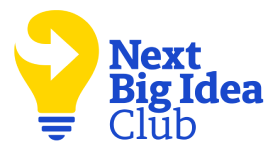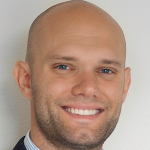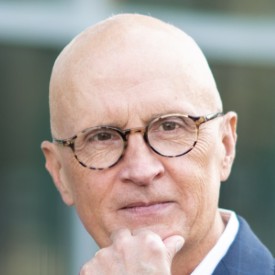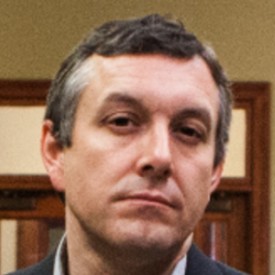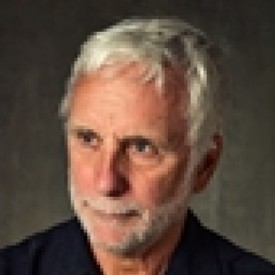James Kimmel, Jr., is a lecturer of psychiatry at the Yale School of Medicine, a lawyer, and the founder and co-director of the Yale Collaborative for Motive Control Studies. He is the creator of The Nonjustice System, the Mircale Court app, and Saving Cain—breakthrough tools for recovering from grievances and revenge desires and preventing mass violence.
What’s the big idea?
Revenge is more than an emotion—it’s an addictive behavior. We get hyped about an epic revenge story to watch on the big screen, or cheer for the politician that will “get even” with our societal oppressors. We ruminate about that person who cut us off on the highway and daydream about how good it would feel to teach their bumper a lesson. Whether real or imagined, the satisfaction of payback is a dangerous craving. The first victim of any revenge story is the mind thinking about it.
Even if you never dole out a sentence in the real world based on the trials held in the courtroom of your mind, those fantasies harm you. By learning the healing power of forgiveness, using established addiction treatment methods, and rewiring our mental machinery, we can free ourselves from the self-inflicted damages of revenge and protect society from cycles of hate.
Below, James shares five key insights from his new book, The Science of Revenge: Understanding the World’s Deadliest Addiction–and How to Overcome It. Listen to the audio version—read by James himself—below, or in the Next Big Idea App.
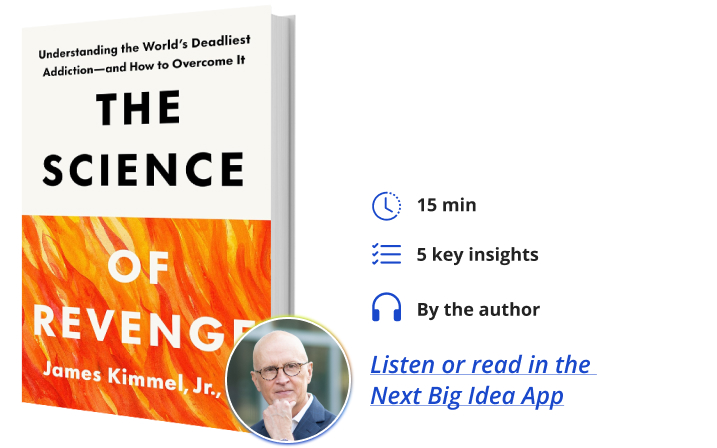
1. Revenge is addictive.
There is a hidden addiction plaguing humanity: revenge. Neuroscientists have identified retaliation as the root cause of most human aggression, from social media outrage and road rage to school shootings, gang violence, domestic abuse, and terrorism. The common thread? The perpetrator nearly always sees themselves as a victim seeking justice. When we’re hurt or humiliated, the brain’s pain-processing center—the anterior insula—activates. In response, we crave relief. When we fantasize about or act on revenge, dopamine floods the brain, lighting up the same neural pathways triggered by opioids or cocaine. But instead of intoxication, we crave payback.
Like any addictive behavior, the high is short-lived and followed by more pain. And the more we ruminate on a grievance, the stronger the cravings become. Most of us can control our urges for revenge, but for some, the dopamine surge can make the desire to “get even” feel irresistible. That’s how otherwise ordinary, peaceable individuals can end up committing extraordinary acts of violence. The key to prevention is recognizing revenge for what it is—not just an emotion, but an addictive behavior that demands a public health response.
2. Violence is a public health issue.
Understanding revenge as an addiction changes everything we thought we knew about why people become violent and how to stop it. For decades, we’ve treated violence as a social or moral problem. But if revenge-seeking follows the same neurobiological pathways as substance use, then violence isn’t just an emotion or moral failing—it’s the behavioral outcome of an unrecognized and untreated addiction.
When scientists embraced the brain disease model of addiction in the late 1990s, it sparked a revolution in research, treatment innovation, funding, and public understanding. We now have the opportunity to apply the same science-based framework to violence prevention.
“Understanding revenge as an addiction changes everything we thought we knew about why people become violent and how to stop it.”
Revenge-seeking is a behavioral addiction. And like other addictions, it can be interrupted and treated. Viewing revenge through the lens of addiction expands our toolbox for treatment. Cognitive behavioral therapy, motivational interviewing, peer support, psychosocial approaches, and even anti-craving medications can be repurposed to help people manage revenge cravings.
3. America has a revenge addiction problem.
From political polarization to courtroom dramas, and from superhero blockbusters to viral Twitter feuds, American society runs on revenge. Our legal system is a billion-dollar industry for selling revenge, packaged as justice. Our politics are fueled by grievance, with political leaders using the language of payback to rally supporters. Public calls to “fight back” and punish enemies reflect not just rhetoric but a deeper pathology: the weaponization of revenge cravings on a national scale.
Even our entertainment is saturated with revenge narratives. Movies from The Lion King to The Avengers celebrate vengeance and create a cultural script that glorifies payback. Meanwhile, social media platforms serve as digital revenge machines, propagating grievances, cueing outrage, and rewarding public shaming with dopamine hits. When these cycles of grievance and retaliation become cultural norms, the result is a society trapped in a feedback loop of addictive violence. To recover, we need to tell new stories that center on healing, not harm.
4. How to unlock the superpower of forgiveness.
Forgiveness often gets framed as a moral virtue—something good people do when they’re feeling generous. But now, modern neuroscience is confirming what spiritual wisdom has taught for centuries, that forgiveness is not just spiritually liberating, but neurologically healing.
Brain scan studies show that simply imagining forgiving a grievance deactivates the brain’s pain network, deactivates the pleasure and craving circuitry of revenge craving, and activates the prefrontal cortex of executive function and self-control. Research also shows that forgiveness reduces symptoms of stress, anxiety, PTSD, and even physical conditions like high blood pressure, pain, and insomnia.
“Refusing to forgive—under the belief that you’re somehow denying a gift to the person who hurt you—achieves little more than denying yourself the healing you need.”
A common misconception is that forgiveness means “giving” something to the person who hurt you. It doesn’t. Forgiveness is part of your brain’s biological pain management and revenge control system. The person who receives the benefits from forgiveness is you, the person who was hurt, not the person who caused the harm. You don’t even have to tell the person who hurt you that you’ve forgiven them to receive these benefits. And you certainly don’t have to overlook or condone their behavior.
Forgiveness is a process that happens inside your brain. Refusing to forgive—under the belief that you’re somehow denying a gift to the person who hurt you—achieves little more than denying yourself the healing you need. That’s a self-inflicted tragedy. Within the biology of the human brain, the person who receives the greatest gift from forgiving is you, the forgiver.
5. The courtroom of the mind.
Before we take revenge in the real world, we often rehearse it in private—inside what I call the courtroom of the mind. This is where we hold imagined trials of the people who hurt us. We play every role: victim, prosecutor, judge, jury, even executioner. We summon evidence, hand down a sentence, and fantasize about carrying it out. Most of us—good, normal people—are routinely putting the people who offend and mistreat us on trial inside the busy courtrooms of our minds. But these internal trials can have real life-and-death consequences. At their conclusion, we will choose whether to carry out our sentences in the real world. If we hope to secure personal and communal peace, harmony, and prosperity—and reduce rage, violence, and aggression in all forms—we must learn how to win the trials taking place inside our minds.
That’s why I developed a 12-step program for revenge addiction recovery called The Nonjustice System (NJS). The NJS is a science-based intervention that utilizes the courtroom of the mind as a tool for healing rather than harm. In this guided role-play (which is also available as a free app called the Miracle Court app), you can imagine putting anybody who has ever wronged you on trial while playing all the roles yourself. This creates space to safely process pain, let go of destructive cravings, and explore forgiveness.
The Nonjustice System and Miracle Court app have been used by people to heal from trauma, overcome intrusive revenge urges and rumination, and set themselves free from the wrongs of the past. Unlike the traditional justice system, the NJS and Miracle Court app aren’t about getting even; they’re about setting yourself free. By harnessing imagination and neuroscience, we can transform the mental machinery of revenge into a path toward wellbeing and recovery.
Enjoy our full library of Book Bites—read by the authors!—in the Next Big Idea App:

